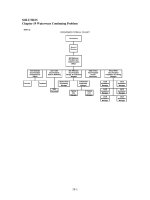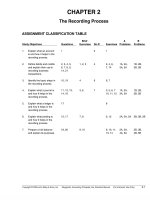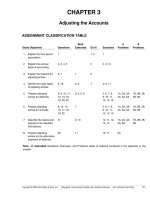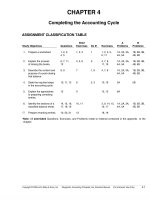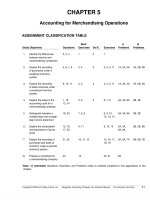Solution manual accounting principles 9e by kieso kimmel chapter 01
Bạn đang xem bản rút gọn của tài liệu. Xem và tải ngay bản đầy đủ của tài liệu tại đây (413.37 KB, 54 trang )
To download more slides, ebook, solutions and test bank, visit
CHAPTER 1
Accounting in Action
ASSIGNMENT CLASSIFICATION TABLE
Brief
Exercises
A
Problems
B
Problems
5, 6, 7, 11
1A, 2A
4A
1B, 2B
4B
6, 7, 8, 9
6, 7, 8,
10, 11
1A, 2A,
4A, 5A
1B, 2B,
4B, 5B
10, 11
9, 12, 13,
14, 15, 16
2A, 3A,
4A, 5A
2B, 3B,
4B, 5B
Study Objectives
Questions
1.
Explain what
accounting is.
2.
Identify the users and
uses of accounting.
3.
Understand why ethics
is a fundamental business
concept.
4.
Explain generally accepted
accounting principles
and the cost principle.
6
5.
Explain the monetary
unit assumption and
the economic entity
assumption.
7, 8, 9, 10
6.
State the accounting
equation, and define
its components.
11, 12, 13,
22
1, 2, 3, 4, 5
7.
Analyze the effects of
business transactions on
the accounting equation.
14, 15, 16,
18
8.
Understand the four
financial statements
and how they are
prepared.
17, 19, 20,
21
Copyright © 2009 John Wiley & Sons, Inc.
Do It!
Exercises
1, 2, 5
1, 2, 4
1
3, 4
6
2
7
3
8
4
4
Weygandt, Accounting Principles, 9/e, Solutions Manual
(For Instructor Use Only)
1-1
To download more slides, ebook, solutions and test bank, visit
ASSIGNMENT CHARACTERISTICS TABLE
Problem
Number
1-2
Description
Difficulty
Level
Time Allotted
(min.)
1A
Analyze transactions and compute net income.
Moderate
40–50
2A
Analyze transactions and prepare income statement,
owner’s equity statement, and balance sheet.
Moderate
50–60
3A
Prepare income statement, owner’s equity statement, and
balance sheet.
Moderate
50–60
4A
Analyze transactions and prepare financial statements.
Moderate
40–50
5A
Determine financial statement amounts and prepare
owner’s equity statement.
Moderate
40–50
1B
Analyze transactions and compute net income.
Moderate
40–50
2B
Analyze transactions and prepare income statement,
owner’s equity statement, and balance sheet.
Moderate
50–60
3B
Prepare income statement, owner’s equity statement, and
balance sheet.
Moderate
50–60
4B
Analyze transactions and prepare financial statements.
Moderate
40–50
5B
Determine financial statement amounts and prepare
owner’s equity statement.
Moderate
40–50
Copyright © 2009 John Wiley & Sons, Inc.
Weygandt, Accounting Principles, 9/e, Solutions Manual
(For Instructor Use Only)
To download more slides, ebook, solutions and test bank, visit
WEYGANDT ACCOUNTING PRINCIPLES 9E
CHAPTER 1
ACCOUNTING IN ACTION
Number
SO
BT
Difficulty
Time (min.)
BE1
6
AP
Simple
2–4
BE2
6
AP
Simple
3–5
BE3
6
AP
Moderate
4–6
BE4
6
AP
Moderate
4–6
BE5
6
C
Simple
2–4
BE6
7
C
Simple
2–4
BE7
7
C
Simple
2–4
BE8
7
C
Simple
2–4
BE9
7
C
Simple
1–2
BE10
8
AP
Simple
3–5
BE11
8
C
Simple
2–4
DI1
1, 2, 4
K
Simple
2–4
DI2
6
K
Simple
2–4
DI3
7
AP
Simple
6–8
DI4
8
AP
Moderate
8–10
EX1
1
C
Moderate
5–7
EX2
2
C
Simple
6–8
EX3
3
C
Moderate
6–8
EX4
4, 5
C
Moderate
6–8
EX5
6
C
Simple
4–6
EX6
6, 7
C
Simple
6–8
EX7
6, 7
C
Simple
4–6
EX8
7
AP
Moderate
12–15
EX9
8
AP
Simple
12–15
EX10
7
AP
Moderate
8–10
EX11
6, 7
AP
Moderate
6–8
EX12
8
AP
Simple
8–10
EX13
8
AN
Simple
8–10
EX14
8
AP
Simple
10–12
EX15
8
AP
Simple
6–8
EX16
8
AP
Moderate
6–8
Copyright © 2009 John Wiley & Sons, Inc.
Weygandt, Accounting Principles, 9/e, Solutions Manual
(For Instructor Use Only)
1-3
To download more slides, ebook, solutions and test bank, visit
ACCOUNTING IN ACTION (Continued)
Number
SO
BT
Difficulty
Time (min.)
P1A
6, 7
AP
Moderate
40–50
P2A
6–8
AP
Moderate
50–60
P3A
8
AP
Moderate
50–60
P4A
6–8
AP
Moderate
40–50
P5A
7, 8
AP
Moderate
40–50
P1B
6, 7
AP
Moderate
40–50
P2B
6–8
AP
Moderate
50–60
P3B
8
AP
Moderate
50–60
P4B
6–8
AP
Moderate
40–50
P5B
7, 8
AP
Moderate
40–50
BYP1
8
AN
Simple
10–15
BYP2
8
AN, E
Simple
10–15
BYP3
9
C, AN
Simple
15–20
BYP4
8
E
Moderate
15–20
BYP5
8
E
Simple
12–15
BYP6
3
E
Simple
10–12
BYP7
3
E
Moderate
15–20
1-4
Copyright © 2009 John Wiley & Sons, Inc.
Weygandt, Accounting Principles, 9/e, Solutions Manual
(For Instructor Use Only)
Copyright © 2009 John Wiley & Sons, Inc.
Weygandt, Accounting Principles, 9/e, Solutions Manual
Identify the users and uses of
accounting.
Understand why ethics is a
fundamental business concept.
Explain generally accepted
accounting principles and the
cost principle.
Explain the monetary unit
assumption and the economic
entity assumption.
State the accounting equation,
and define its components.
Analyze the effects of business
transactions on the accounting
equation.
Understand the four financial
statements and how they are
prepared.
2.
3.
4.
5.
6.
7.
8.
Broadening Your Perspective
Explain what accounting is.
1.
Study Objective
Q1-11
Q1-12
Q1-22
DI1-2
Q1-8
Q1-9
DI1-1
DI1-1
DI1-1
BE1-7
BE1-8
BE1-9
E1-6
E1-7
E1-6
E1-7
E1-2
Q1-5
E1-1
Exploring the Web
Q1-17
Q1-19
BE1-11
Q1-14
Q1-15
Q1-16
Q1-18
BE1-6
Q1-13
BE1-5
E1-5
Q1-7
Q1-10
E1-4
Q1-6
E1-4
E1-3
Q1-3
Q1-4
Q1-1
Q1-2
Knowledge Comprehension
Q1-20
Q1-21
BE1-10
DI1-4
E1-9
E1-12
E1-14
E1-15
E1-16
DI1-3
E1-8
E1-10
E1-11
P1-1A
P1-2A
BE1-1
BE1-2
BE1-3
BE1-4
E1-11
P1-1A
Analysis
Financial Reporting
Comparative Analysis
Exploring the Web
P1-2A E1-13
P1-3A
P1-4A
P1-5A
P1-2B
P1-3B
P1-4B
P1-5B
P1-4A
P1-5A
P1-1B
P1-2B
P1-4B
P1-5B
P1-2A
P1-4A
P1-1B
P1-2B
P1-4B
Application
Synthesis
All About You
Comparative Analysis
Decision Making Across
the Organization
Communication Activity
Ethics Case
Evaluation
Correlation Chart between Bloom’s Taxonomy, Study Objectives and End-of-Chapter Exercises and Problems
To download more slides, ebook, solutions and test bank, visit
BLOOM’S TAXONOMY TABLE
(For Instructor Use Only)
1-5
To download more slides, ebook, solutions and test bank, visit
ANSWERS TO QUESTIONS
1.
Yes, this is correct. Virtually every organization and person in our society uses accounting
information. Businesses, investors, creditors, government agencies, and not-for-profit organizations
must use accounting information to operate effectively.
2.
Accounting is the process of identifying, recording, and communicating the economic events of
an organization to interested users of the information. The first step of the accounting process is
therefore to identify economic events that are relevant to a particular business. Once identified
and measured, the events are recorded to provide a history of the financial activities of the
organization. Recording consists of keeping a chronological diary of these measured events in an
orderly and systematic manner. The information is communicated through the preparation and
distribution of accounting reports, the most common of which are called financial statements.
A vital element in the communication process is the accountant’s ability and responsibility to
analyze and interpret the reported information.
3.
(a) Internal users are those who plan, organize, and run the business and therefore are officers
and other decision makers.
(b) To assist management, managerial accounting provides internal reports. Examples include
financial comparisons of operating alternatives, projections of income from new sales
campaigns, and forecasts of cash needs for the next year.
4.
(a) Investors (owners) use accounting information to make decisions to buy, hold, or sell ownership shares of a company.
(b) Creditors use accounting information to evaluate the risks of granting credit or lending money.
5.
Bookkeeping usually involves only the recording of economic events and therefore is just one part
of the entire accounting process. Accounting, on the other hand, involves the entire process of
identifying, recording, and communicating economic events.
6.
Karen Sommers Travel Agency should report the land at $90,000 on its December 31, 2010
balance sheet. An important concept that accountants follow is the cost principle. The cost
principle states that assets should be recorded at their cost. Cost has an important advantage
over other valuations: it is reliable. Cost can be objectively measured and can be verified.
7.
The monetary unit assumption requires that only transaction data that can be expressed in terms
of money be included in the accounting records. This assumption enables accounting to quantify
(measure) economic events.
8.
The economic entity assumption requires that the activities of the entity be kept separate and
distinct from the activities of its owners and all other economic entities.
9.
The three basic forms of business organizations are: (1) proprietorship, (2) partnership, and
(3) corporation.
1-6
Copyright © 2009 John Wiley & Sons, Inc.
Weygandt, Accounting Principles, 9/e, Solutions Manual
(For Instructor Use Only)
To download more slides, ebook, solutions and test bank, visit
Questions Chapter 1 (Continued)
10.
One of the advantages Maria Gonzalez would enjoy is that ownership of a corporation is represented by transferable shares of stock. This would allow Maria to raise money easily by selling
a part of her ownership in the company. Another advantage is that because holders of the shares
(stockholders) enjoy limited liability; they are not personally liable for the debts of the corporate
entity. Also, because ownership can be transferred without dissolving the corporation, the corporation
enjoys an unlimited life.
11.
The basic accounting equation is Assets = Liabilities + Owner’s Equity.
12.
(a) Assets are resources owned by a business. Liabilities are claims against assets. Put more
simply, liabilities are existing debts and obligations. Owner’s equity is the ownership claim
on total assets.
(b) Owner’s equity is affected by owner’s investments, drawings, revenues, and expenses.
13.
The liabilities are: (b) Accounts payable and (g) Salaries payable.
14.
Yes, a business can enter into a transaction in which only the left side of the accounting equation
is affected. An example would be a transaction where an increase in one asset is offset by
a decrease in another asset. An increase in the Equipment account which is offset by a decrease
in the Cash account is a specific example.
15.
Business transactions are the economic events of the enterprise recorded by accountants
because they affect the basic equation.
(a) The death of the owner of the company is not a business transaction as it does not affect the
basic equation.
(b) Supplies purchased on account is a business transaction as it affects the basic equation.
(c) An employee being fired is not a business transaction as it does not affect the basic equation.
(d) A withdrawal of cash from the business is a business transaction as it affects the basic equation.
16.
(a) Decrease assets and decrease owner’s equity.
(b) Increase assets and decrease assets.
(c) Increase assets and increase owner’s equity.
(d) Decrease assets and decrease liabilities.
17.
(a) Income statement.
(b) Balance sheet.
(c) Income statement.
18.
No, this treatment is not proper. While the transaction does involve a receipt of cash, it does not
represent revenues. Revenues are the gross increase in owner’s equity resulting from business
activities entered into for the purpose of earning income. This transaction is simply an additional
investment made by the owner in the business.
19.
Yes. Net income does appear on the income statement—it is the result of subtracting expenses
from revenues. In addition, net income appears in the statement of owner’s equity—it is shown as
an addition to the beginning-of-period capital. Indirectly, the net income of a company is also
included in the balance sheet. It is included in the capital account which appears in the owner’s
equity section of the balance sheet.
Copyright © 2009 John Wiley & Sons, Inc.
(d) Balance sheet.
(e) Balance sheet and owner’s equity statement.
(f) Balance sheet.
Weygandt, Accounting Principles, 9/e, Solutions Manual
(For Instructor Use Only)
1-7
To download more slides, ebook, solutions and test bank, visit
Questions Chapter 1 (Continued)
20.
21.
22.
1-8
(a) Ending capital balance .....................................................................................................
Beginning capital balance................................................................................................
Net income..........................................................................................................................
$198,000
168,000
$ 30,000
(b)
Deduct: Investment ..........................................................................................................
Net income..........................................................................................................................
$198,000
168,000
30,000
13,000
$ 17,000
(a) Total revenues ($20,000 + $70,000) .............................................................................
$90,000
(b)
Total expenses ($26,000 + $40,000).............................................................................
$66,000
(c)
Total revenues ...................................................................................................................
Total expenses...................................................................................................................
Net income..........................................................................................................................
$90,000
66,000
$24,000
Ending capital balance .....................................................................................................
Beginning capital balance................................................................................................
Coca-Cola’s accounting equation at December 31, 2007 was $43,269,000,000 = $21,525,000,000 +
$21,744,000,000.
Copyright © 2009 John Wiley & Sons, Inc.
Weygandt, Accounting Principles, 9/e, Solutions Manual
(For Instructor Use Only)
To download more slides, ebook, solutions and test bank, visit
SOLUTIONS TO BRIEF EXERCISES
BRIEF EXERCISE 1-1
(a) $90,000 – $50,000 = $40,000 (Owner’s Equity).
(b) $40,000 + $70,000 = $110,000 (Assets).
(c) $94,000 – $60,000 = $34,000 (Liabilities).
BRIEF EXERCISE 1-2
(a) $120,000 + $232,000 = $352,000 (Total assets).
(b) $190,000 – $80,000 = $110,000 (Total liabilities).
(c) $800,000 – 0.5($800,000) = $400,000 (Owner’s equity).
BRIEF EXERCISE 1-3
(a) ($800,000 + $150,000) – ($500,000 – $80,000) = $530,000
(Owner’s equity).
(b) ($500,000 + $100,000) + ($800,000 – $500,000 – $70,000) = $830,000
(Assets).
(c) ($800,000 – $80,000) – ($800,000 – $500,000 + $120,000) = $300,000
(Liabilities).
BRIEF EXERCISE 1-4
Owner’s Equity
Assets
=
Liabilities
+
Owner,
Capital
(a)
X
X
X
= $90,000
= $90,000
= $330,000
(b)
$57,000
$57,000
X
=
X
+ $25,000
=
X
+ $33,000
= $24,000 ($57,000 – $33,000)
(c)
$600,000 = ($600,000 x 2/3) + X (Owner’s equity)
$600,000 = $400,000
+ X
X
= $200,000
Copyright © 2009 John Wiley & Sons, Inc.
+ $150,000
+ $240,000
Owner
– Drawings + Revenues – Expenses
–
$40,000 + $450,000 – $320,000
– $7,000
+
$50,000
Weygandt, Accounting Principles, 9/e, Solutions Manual
–
$35,000
(For Instructor Use Only)
1-9
To download more slides, ebook, solutions and test bank, visit
BRIEF EXERCISE 1-5
A
L
A
(a) Accounts receivable
(b) Salaries payable
(c) Equipment
A
OE
L
(d) Office supplies
(e) Owner’s investment
(f) Notes payable
BRIEF EXERCISE 1-6
(a)
(b)
(c)
Assets
Liabilities
Owner’s Equity
+
+
–
+
NE
NE
NE
+
–
BRIEF EXERCISE 1-7
Assets
+
–
NE
(a)
(b)
(c)
Liabilities
NE
NE
NE
Owner’s Equity
+
–
NE
BRIEF EXERCISE 1-8
E
R
E
E
(a)
(b)
(c)
(d)
Advertising expense
Commission revenue
Insurance expense
Salaries expense
D
R
E
(e) Bergman, Drawing
(f) Rent revenue
(g) Utilities expense
BRIEF EXERCISE 1-9
R
NOE
E
1-10
(a) Received cash for services performed
(b) Paid cash to purchase equipment
(c) Paid employee salaries
Copyright © 2009 John Wiley & Sons, Inc.
Weygandt, Accounting Principles, 9/e, Solutions Manual
(For Instructor Use Only)
To download more slides, ebook, solutions and test bank, visit
BRIEF EXERCISE 1-10
LOPEZ COMPANY
Balance Sheet
December 31, 2010
Assets
Cash ................................................................................................................
Accounts receivable..................................................................................
Total assets .........................................................................................
$ 49,000
72,500
$121,500
Liabilities and Owner’s Equity
Liabilities
Accounts payable..............................................................................
Owner’s equity
Kim Lopez, Capital ............................................................................
Total liabilities and owner’s equity.....................................
$ 90,000
31,500
$121,500
BRIEF EXERCISE 1-11
BS
IS
OE, BS
BS
IS
(a)
(b)
(c)
(d)
(e)
Notes payable
Advertising expense
Trent Buchanan, Capital
Cash
Service revenue
SOLUTIONS FOR DO IT! REVIEW EXERCISES
DO IT! 1-1
1.
2.
3.
4.
5.
False. The three steps in the accounting process are identification,
recording, and communication.
True
False. Congress passed the Sarbanes-Oxley Act of 2002 to reduce
unethical behavior and decrease the likelihood of future corporate
scandals.
False. The primary accounting standard-setting body in the United
States is the Financial Accounting Standards Board (FASB).
True.
Copyright © 2009 John Wiley & Sons, Inc.
Weygandt, Accounting Principles, 9/e, Solutions Manual
(For Instructor Use Only)
1-11
To download more slides, ebook, solutions and test bank, visit
DO IT! 1-2
1.
2.
3.
4.
Drawings is owner’s drawings (D); it decreases owner’s equity.
Rent Revenue is revenue (R); it increases owner’s equity.
Advertising Expense is an expense (E); it decreases owner’s equity.
When the owner puts personal assets into the business, it is investment
by owner (I); it increases owner’s equity.
DO IT! 1-3
Assets
Cash
(1)
(2) +$20,000
(3)
(4) –$ 5,000
Liabilities
Owner’s Equity
Accounts
Accounts
O. Cabrera,
O. Cabrera,
+ Receivable = Payable +
Capital
– Drawings + Revenues – Expenses
+$20,000
–$20,000
+$20,000
+$2,000
–$2,000
–$5,000
DO IT! 1-4
(a) The total assets are $49,500, comprised of Cash $7,000, Accounts
Receivable $13,500, and Equipment $29,000.
(b) Net income is $21,000, computed as follows:
Revenues
Service revenue..........................................................
Expenses
Rent expense...............................................................
Salaries expense ........................................................
Advertising expense .................................................
Total expenses ..................................................
Net income ............................................................................
1-12
Copyright © 2009 John Wiley & Sons, Inc.
$54,000
$10,500
$16,500
6,000
Weygandt, Accounting Principles, 9/e, Solutions Manual
33,000
$21,000
(For Instructor Use Only)
To download more slides, ebook, solutions and test bank, visit
DO IT! 1-4 (Continued)
(c) The ending owner’s equity balance of Broadway Company is $21,500.
By rewriting the accounting equation, we can compute Owner’s Equity
as Assets minus Liabilities, as follows:
Total assets [as computed in (a)]...................................
Less: Liabilities
Notes payable ..............................................................
Accounts payable.......................................................
Owner’s equity .....................................................................
$49,500
$25,000
3,000
28,000
$21,500
Note that it is not possible to determine the company’s owner’s equity in
any other way, because the beginning balance for owner’s equity is not
provided.
Copyright © 2009 John Wiley & Sons, Inc.
Weygandt, Accounting Principles, 9/e, Solutions Manual
(For Instructor Use Only)
1-13
To download more slides, ebook, solutions and test bank, visit
SOLUTIONS TO EXERCISES
EXERCISE 1-1
C
R
C
R
R
C
C
I
R
Analyzing and interpreting information.
Classifying economic events.
Explaining uses, meaning, and limitations of data.
Keeping a systematic chronological diary of events.
Measuring events in dollars and cents.
Preparing accounting reports.
Reporting information in a standard format.
Selecting economic activities relevant to the company.
Summarizing economic events.
EXERCISE 1-2
(a)
Internal users
Marketing manager
Production supervisor
Store manager
Vice-president of finance
External users
Customers
Internal Revenue Service
Labor unions
Securities and Exchange Commission
Suppliers
(b)
I
E
I
E
I
I
E
Can we afford to give our employees a pay raise?
Did the company earn a satisfactory income?
Do we need to borrow in the near future?
How does the company’s profitability compare to other companies?
What does it cost us to manufacture each unit produced?
Which product should we emphasize?
Will the company be able to pay its short-term debts?
1-14
Copyright © 2009 John Wiley & Sons, Inc.
Weygandt, Accounting Principles, 9/e, Solutions Manual
(For Instructor Use Only)
To download more slides, ebook, solutions and test bank, visit
EXERCISE 1-3
Larry Smith, president of Smith Company, instructed Ron Rivera, the head of
the accounting department, to report the company’s land in their accounting
reports at its market value of $170,000 instead of its cost of $100,000, in an
effort to make the company appear to be a better investment. The cost
principle requires that assets be recorded and reported at their cost,
because cost is reliable and can be objectively measured and verified.
The stakeholders include stockholders and creditors of Smith Company,
potential stockholders and creditors, other users of Smith’s accounting
reports, Larry Smith, and Ron Rivera. All users of Smith’s accounting reports
could be harmed by relying on information which violates accounting
principles. Larry Smith could benefit if the company is able to attract more
investors, but would be harmed if the fraudulent reporting is discovered.
Similarly, Ron Rivera could benefit by pleasing his boss, but would be
harmed if the fraudulent reporting is discovered.
Ron’s alternatives are to report the land at $100,000 or to report it at
$170,000. Reporting the land at $170,000 is not appropriate since it would
mislead many people who rely on Smith’s accounting reports to make financial decisions. Ron should report the land at its cost of $100,000. He should
try to convince Larry Smith that this is the appropriate course of action, but
be prepared to resign his position if Smith insists.
EXERCISE 1-4
1.
Incorrect. The cost principle requires that assets be recorded and reported
at their cost.
2.
Correct. The monetary unit assumption requires that companies include
in the accounting records only transaction data that can be expressed
in terms of money.
3.
Incorrect. The economic entity assumption requires that the activities of
the entity be kept separate and distinct from the activities of its owner
and all other economic entities.
Copyright © 2009 John Wiley & Sons, Inc.
Weygandt, Accounting Principles, 9/e, Solutions Manual
(For Instructor Use Only)
1-15
To download more slides, ebook, solutions and test bank, visit
EXERCISE 1-5
Asset
Cash
Cleaning equipment
Cleaning supplies
Accounts receivable
Liability
Accounts payable
Notes payable
Salaries payable
Owner’s Equity
Karin Meredith, Capital
EXERCISE 1-6
1.
2.
3.
4.
5.
6.
7.
8.
9.
Increase in assets and increase in owner’s equity.
Decrease in assets and decrease in owner’s equity.
Increase in assets and increase in liabilities.
Increase in assets and increase in owner’s equity.
Decrease in assets and decrease in owner’s equity.
Increase in assets and decrease in assets.
Increase in liabilities and decrease in owner’s equity.
Increase in assets and decrease in assets.
Increase in assets and increase in owner’s equity.
EXERCISE 1-7
1.
2.
3.
4.
(c)
(d)
(a)
(b)
5.
6.
7.
8.
(d)
(b)
(e)
(f)
EXERCISE 1-8
(a) 1.
2.
3.
4.
5.
1-16
Owner invested $15,000 cash in the business.
Purchased office equipment for $5,000, paying $2,000 in cash and
the balance of $3,000 on account.
Paid $750 cash for supplies.
Earned $8,300 in revenue, receiving $4,600 cash and $3,700 on
account.
Paid $1,500 cash on accounts payable.
Copyright © 2009 John Wiley & Sons, Inc.
Weygandt, Accounting Principles, 9/e, Solutions Manual
(For Instructor Use Only)
To download more slides, ebook, solutions and test bank, visit
EXERCISE 1-8 (Continued)
6.
7.
8.
9.
10.
Owner withdrew $2,000 cash for personal use.
Paid $650 cash for rent.
Collected $450 cash from customers on account.
Paid salaries of $4,900.
Incurred $500 of utilities expense on account.
(b) Investment .............................................................................................
Service revenue ...................................................................................
Drawings.................................................................................................
Rent expense ........................................................................................
Salaries expense..................................................................................
Utilities expense...................................................................................
Increase in capital ...............................................................................
$15,000
8,300
(2,000)
(650)
(4,900)
(500)
$15,250
(c) Service revenue ...................................................................................
Rent expense ........................................................................................
Salaries expense..................................................................................
Utilities expense...................................................................................
Net income.............................................................................................
$8,300
(650)
(4,900)
(500)
$2,250
EXERCISE 1-9
S. MOSES & CO.
Income Statement
For the Month Ended August 31, 2010
Revenues
Service revenue ...................................................................
Expenses
Salaries expense..................................................................
Rent expense ........................................................................
Utilities expense...................................................................
Total expenses ............................................................
Net income......................................................................................
Copyright © 2009 John Wiley & Sons, Inc.
Weygandt, Accounting Principles, 9/e, Solutions Manual
$8,300
$4,900
650
500
6,050
$2,250
(For Instructor Use Only)
1-17
To download more slides, ebook, solutions and test bank, visit
EXERCISE 1-9 (Continued)
S. MOSES & CO.
Owner’s Equity Statement
For the Month Ended August 31, 2010
S. Moses, Capital, August 1 ................................................
Add: Investments.................................................................
Net income...................................................................
$
$15,000
2,250
Less: Drawings ......................................................................
S. Moses, Capital, August 31 ..............................................
0
17,250
17,250
2,000
$15,250
S. MOSES & CO.
Balance Sheet
August 31, 2010
Assets
Cash ................................................................................................................
Accounts receivable ..................................................................................
Supplies .........................................................................................................
Office equipment.........................................................................................
Total assets..........................................................................................
$ 8,250
3,250
750
5,000
$17,250
Liabilities and Owner’s Equity
Liabilities
Accounts payable ..............................................................................
Owner’s equity
S. Moses, Capital................................................................................
Total liabilities and owner’s equity .....................................
$ 2,000
15,250
$17,250
EXERCISE 1-10
(a) Owner’s equity—12/31/09 ($400,000 – $250,000).....................
Owner’s equity—1/1/09 ....................................................................
Increase in owner’s equity..............................................................
Add: Drawings ..................................................................................
Net income for 2009 ..........................................................................
1-18
Copyright © 2009 John Wiley & Sons, Inc.
Weygandt, Accounting Principles, 9/e, Solutions Manual
$150,000
100,000
50,000
15,000
$ 65,000
(For Instructor Use Only)
To download more slides, ebook, solutions and test bank, visit
EXERCISE 1-10 (Continued)
(b) Owner’s equity—12/31/10 ($460,000 – $300,000) ..................
Owner’s equity—1/1/10—see (a).................................................
Increase in owner’s equity ...........................................................
Less: Additional investment.......................................................
Net loss for 2010 ..............................................................................
$160,000
150,000
10,000
50,000
$ 40,000
(c) Owner’s equity—12/31/11 ($590,000 – $400,000) ..................
Owner’s equity—1/1/11—see (b) ................................................
Increase in owner’s equity ...........................................................
Less: Additional investment.......................................................
$190,000
160,000
30,000
15,000
15,000
30,000
$ 45,000
Add: Drawings ...............................................................................
Net income for 2011........................................................................
EXERCISE 1-11
(a) Total assets (beginning of year).................................................
Total liabilities (beginning of year) ............................................
Total owner’s equity (beginning of year).................................
$ 95,000
85,000
$ 10,000
(b) Total owner’s equity (end of year) .............................................
Total owner’s equity (beginning of year).................................
Increase in owner’s equity ...........................................................
$ 40,000
10,000
$ 30,000
Total revenues..................................................................................
Total expenses .................................................................................
Net income.........................................................................................
$215,000
175,000
$ 40,000
Increase in owner’s equity ..................................
Less: Net income...................................................
Add: Drawings ......................................................
Additional investment...........................................
$ 30,000
$(40,000)
24,000)
(c) Total assets (beginning of year).................................................
Total owner’s equity (beginning of year).................................
Total liabilities (beginning of year) ............................................
Copyright © 2009 John Wiley & Sons, Inc.
Weygandt, Accounting Principles, 9/e, Solutions Manual
(16,000)
$ 14,000
$129,000
80,000
$ 49,000
(For Instructor Use Only)
1-19
To download more slides, ebook, solutions and test bank, visit
EXERCISE 1-11 (Continued)
(d) Total owner’s equity (end of year)..............................................
Total owner’s equity (beginning of year) .................................
Increase in owner’s equity............................................................
$130,000
80,000
$ 50,000
Total revenues ..................................................................................
Total expenses..................................................................................
Net income .........................................................................................
$100,000
55,000
$ 45,000
Increase in owner’s equity...................................
Less: Net income ...................................................
Additional investment ..............................
Drawings ....................................................................
$ 50,000
$(45,000)
(25,000)
(70,000)
$ 20,000
EXERCISE 1-12
LINDA STANLEY CO.
Income Statement
For the Year Ended December 31, 2010
Revenues
Service revenue..............................................................
Expenses
Salaries expense ............................................................
Rent expense...................................................................
Utilities expense.............................................................
Advertising expense .....................................................
Total expenses.......................................................
Net income ................................................................................
$62,500
$30,000
10,400
3,100
1,800
45,300
$17,200
LINDA STANLEY CO.
Owner’s Equity Statement
For the Year Ended December 31, 2010
Linda Stanley, Capital, January 1............................................................
Add: Net income .........................................................................................
Less: Drawings.............................................................................................
Linda Stanley, Capital, December 31 .....................................................
1-20
Copyright © 2009 John Wiley & Sons, Inc.
Weygandt, Accounting Principles, 9/e, Solutions Manual
$48,000
17,200
65,200
6,000
$59,200
(For Instructor Use Only)
To download more slides, ebook, solutions and test bank, visit
EXERCISE 1-13
MENDEZ COMPANY
Balance Sheet
December 31, 2010
Assets
Cash ................................................................................................................
Accounts receivable..................................................................................
Supplies.........................................................................................................
Equipment.....................................................................................................
Total assets .........................................................................................
$15,000
8,500
8,000
46,000
$77,500
Liabilities and Owner’s Equity
Liabilities
Accounts payable..............................................................................
Owner’s equity
Mendez, Capital ($67,500 – $10,000) ...........................................
Total liabilities and owner’s equity.....................................
$20,000
57,500
$77,500
EXERCISE 1-14
(a) Camping fee revenues .....................................................................
General store revenues ...................................................................
Total revenue .............................................................................
Expenses..............................................................................................
Net income...........................................................................................
(b)
$140,000
50,000
190,000
150,000
$ 40,000
DEER PARK
Balance Sheet
December 31, 2010
Assets
Cash .......................................................................................................
Supplies................................................................................................
Equipment............................................................................................
Total assets ................................................................................
Copyright © 2009 John Wiley & Sons, Inc.
Weygandt, Accounting Principles, 9/e, Solutions Manual
$ 23,000
2,500
105,500
$131,000
(For Instructor Use Only)
1-21
To download more slides, ebook, solutions and test bank, visit
EXERCISE 1-14 (Continued)
DEER PARK
Balance Sheet (Continued)
December 31, 2010
Liabilities and Owner’s Equity
Liabilities
Notes payable.............................................................................
Accounts payable .....................................................................
Total liabilities ...................................................................
Owner’s equity
Jan Nab, Capital ($131,000 – $71,000)................................
Total liabilities and owner’s equity ............................
$ 60,000
11,000
71,000
60,000
$131,000
EXERCISE 1-15
SUMMERS CRUISE COMPANY
Income Statement
For the Year Ended December 31, 2010
Revenues
Ticket revenue............................................................
Expenses
Salaries expense .......................................................
Maintenance expense..............................................
Property tax expense...............................................
Advertising expense ................................................
Total expenses..................................................
Net income ...........................................................................
$325,000
$142,000
95,000
10,000
3,500
250,500
$ 74,500
EXERCISE 1-16
KEVIN JOHNSON, ATTORNEY
Owner’s Equity Statement
For the Year Ended December 31, 2010
Kevin Johnson, Capital, January 1 ...............................................
Add: Net income ...............................................................................
Less: Drawings...................................................................................
Kevin Johnson, Capital, December 31.........................................
$ 23,000 (a)
139,000 (b)
162,000
79,000
$ 83,000 (c)
1-22
(For Instructor Use Only)
Copyright © 2009 John Wiley & Sons, Inc.
Weygandt, Accounting Principles, 9/e, Solutions Manual
To download more slides, ebook, solutions and test bank, visit
EXERCISE 1-16 (Continued)
Supporting Computations
(a) Assets, January 1, 2010 ..................................................................
Liabilities, January 1, 2010.............................................................
Capital, January 1, 2010 ..................................................................
$ 85,000
62,000
$ 23,000
(b) Legal service revenue......................................................................
Total expenses ...................................................................................
Net income...........................................................................................
$350,000
211,000
$139,000
(c) Assets, December 31, 2010 ............................................................
Liabilities, December 31, 2010 ......................................................
Capital, December 31, 2010............................................................
$168,000
85,000
$ 83,000
Copyright © 2009 John Wiley & Sons, Inc.
Weygandt, Accounting Principles, 9/e, Solutions Manual
(For Instructor Use Only)
1-23
1-24
Copyright © 2009 John Wiley & Sons, Inc.
–400
4,600
–500
4,100
3. +
+
4. +
+
4,100
+
–140
6,060
9. +
+
Weygandt, Accounting Principles, 9/e, Solutions Manual
+120
6,060 +
+$ 6,180 +
11. –
+
10. +000,000
6,200
+
+$750
+ +$500 +
+ + 500 +
$12,310
+$630
+–120
+ 750
+0000
+ + 500 +
+0000
+ + 500 +
+0000
+ + 500 +
+0000
–1,000
8,200
+ + 500 +
+0000
+ + 500 +
+0000
+ + 500 +
+$500
+
+
9,200
8. + –2,000
7.
+
6. – +5,100
+
5. +000,000
5,000
+
2. + –5,000
+$5,000 =
+ 5,000 =
+00,000
+ 5,000 =
+00,000
+ 5,000 =
+00,000
+ 5,000 =
+00,000
+ 5,000 =
+00,000
+ 5,000 =
+00,000
+ 5,000 =
+00,000
+ 5,000 =
+00,000
+ 5,000 =
+$5,000
+$250
+0250
+0000
+0250
+0000
+ 250
+0000
+ 250
+0000
+ 250
+0000
+ 250
+$250
10,000
–
10,000
+
10,000
+000,000
10,000
+ +$10,000 –
+ + 10,000
–
+ + 10,000
+
+ + 10,000
+
+ + 10,000
+
+
+
+
+
+ + 10,000
+000,000
+ 10,000
+ 10,000
=
+$10,000
Cash
$12,310
$1,000
–1,000
–1,000
–1,000
–1,000
–$1,000
+
$5,850
5,850
+750
5,100
5,100
5,100
5,100
+$5,100
–
$2,790
–2,790
–2,790
–140
–2,650
–2,000
–650
–650
–650
–250
–400
–400
–$400
Owner’s Equity
Accounts
Accounts N. Barone, N. Barone,
+ Receivable + Supplies + Equipment = Payable + Capital – Drawings + Revenues – Expenses
BARONE REPAIR SHOP
1. +$10,000
(a)
To download more slides, ebook, solutions and test bank, visit
SOLUTIONS TO PROBLEMS
PROBLEM 1-1A
(For Instructor Use Only)
To download more slides, ebook, solutions and test bank, visit
PROBLEM 1-1A (Continued)
(b) Service revenue ($5,100 + $750)..................................
Expenses
Salaries ......................................................................
Rent .............................................................................
Advertising ...............................................................
Utilities .......................................................................
Net income .......................................................
Copyright © 2009 John Wiley & Sons, Inc.
Weygandt, Accounting Principles, 9/e, Solutions Manual
$5,850
$2,000
400
250
140
2,790
$3,060
(For Instructor Use Only)
1-25
